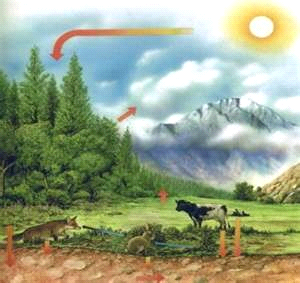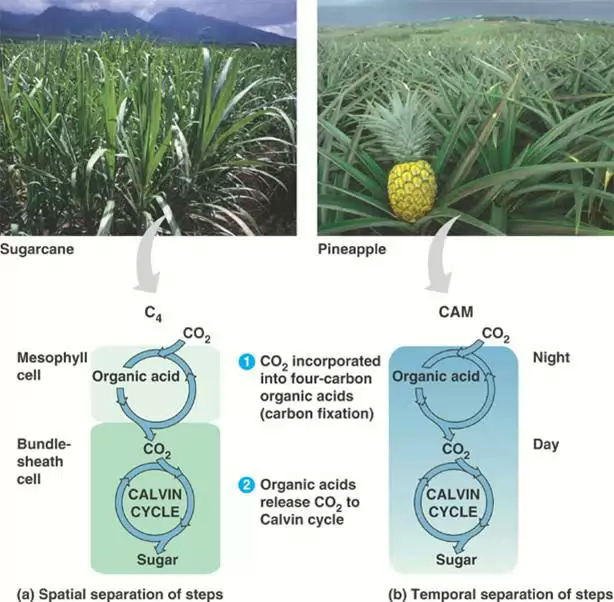Арсланова_Г_А_и_др_Essential_English_for_Biology_Students (1). Kazan federal university
 Скачать 7.01 Mb. Скачать 7.01 Mb.
|
Text 7.3. Photosynthesis In Different Climates■  Essential targets: Essential targets:By the end of this text you should be able to: distinguish between C3 and C4 plants; explain the advantages and disadvantages of crassulacean acid metabolism (CAM); give examples of C3, C4, and CAM plants. Pre-reading ■ With a partner, consider the following questions and try to answer them. Then quickly scan the text to check your answers. 1. What is necessary for plants to survive in different climates? 2. Do you know the ways of fixing carbon dioxide? ■ Read the given text and make your essential assignments: Green plants thrive in environments ranging from hot and dry equatorial regions to freezing-cold polar regions. Their success depends on their adaptability. To survive and breed, each plant has had to evolve specific adaptations to cope with the demands of its particular environment. These adaptations include ways of fixing carbon dioxide. C3 plants: fixing directly into the Calvin cycle C3 plants fix carbon dioxide directly into the Calvin cycle as the three-carbon compound glycerate 3-phosphate (GP). Common and widely distributed, they include some of our most important crop plants such as wheat, soya beans, and rice. C3 plants function efficiently in temperature conditions. However, they suffer two major disadvantages in hot, dry environments. First, to obtain sufficient carbon dioxide, C3 plants must open their stomata (small pores in their leaves). Unfortunately, when stomata are open, they not only allow carbon dioxide to enter the plant, but also allow water to escape. So in hot dry conditions C3 plants have to either cease photosynthesising or run the risk of wilting and dying. The second disadvantage relates to the ability of ribulose biphosphate carboxylase (ribosco) to combine with oxygen. Ribosco is the enzyme that catalyses carbon dioxide fixation. On a hot, sunny day carbon dioxide concentrations around photosynthesising cells decrease, because a large proportion of the carbon dioxide is being used up on photosynthesis. In these conditions, ribosco combines with oxygen rather than carbon dioxide in a process called photorespiration. The process results in the loss of fixed carbon dioxide from the plant, reducing photosynthetic efficiently and plant growth. Unlike photosynthesis, photorespiration does not produce sugar molecules; and unlike respiration, it yields no ATP. As much as half of the carbon dioxide fixed in the Calvin cycle may be released by photorespiration. Therefore, in hot, arid conditions, or in conditions where carbon dioxide levels are low, C3 plants do not grow well. C4 plants: the Hatch-Slack pathway C4 plants have evolved a special metabolic adaptation which reduces photorespiration. They do not use ribulose biphosphate (RuBP) to fix carbon dioxide directly into the Calvin cycle. Instead, they use phosphoenolpyruvate (PEP) to fix carbon dioxide as a four-carbon compound, oxaloacetate. The reaction is catalysed by phosphoenolpyruvate carboxylase (PEP, carboxylase). This enzyme cannot combine with oxygen. Consequently C4 plants can continue to fix carbon dioxide even when its concentration is very low. The leaves of C4 plants are specially adapted to carry out this initial fixation. A ring of large closely packed cells called the bundle sheath surrounds the leaf veins. Surrounding the bundle sheath is a smaller ring of mesophyll cells. The distinctive arrangement is called Kranz anatomy and can be used to identify C4 plants (“Kranz” means crown or halo and refers to the two distinctive rings). The initial fixation of carbon dioxide into oxaloacetate takes place in the small ring of mesophyll cells. Then the oxaloacetate is converted to malate, another four-carbon compound. Malate is transported into the bundle sheath cells where it releases carbon dioxide. Once released, the carbon dioxide is reassimilated by RuBP and enters the Calvin cycle in the same way as described for C3 plants. The metabolic pathway that transports carbon dioxide into the bundle sheath cells is called the Hatch-Slack pathway. As a result of this pathway, the concentration of carbon dioxide in the bundle sheath cells is 20 to 120 times higher than normal. C  4 plants have two main advantages in hot, dry environments. First, because PEP carboxylase has a high affinity for carbon dioxide and does not combine with oxygen, C4 plants can continue to photosynthesise even when their stomata are closed for long periods. This reduces water loss and photorespiration. C4 plants need only about half as much water as C3 plants for photosynthesis. Secondly, because high carbon dioxide concentrations can be maintained in the bundle sheath cells, C4 plants can increase their photosynthetic efficiency. 4 plants have two main advantages in hot, dry environments. First, because PEP carboxylase has a high affinity for carbon dioxide and does not combine with oxygen, C4 plants can continue to photosynthesise even when their stomata are closed for long periods. This reduces water loss and photorespiration. C4 plants need only about half as much water as C3 plants for photosynthesis. Secondly, because high carbon dioxide concentrations can be maintained in the bundle sheath cells, C4 plants can increase their photosynthetic efficiency.These adaptations enable C4 plants to outcome C3 plants in hot and very sunny conditions, but not in temperate conditions. Fewer than 0.5 per cent of plant species are C4 plants, yet they include economically important crops such as maize, sugar cane, and millet. CAM plants: photosynthesizing in the desert Although C4 plants are well adapted to occasional periods of drought, they cannot cope well with desert conditions. A group of plants including cacti and pineapples have evolved a third type of carbon dioxide fixation which enables them to survive in very dry climates. These plants are called CAM plants. CAM is an abbreviation for crassulacean acid metabolism, a type of metabolism first observed in the family of plants called Crassulaceae (which includes the stonecrops, fleshy-leaved plants that will grow on rocks and walls). CAM plants conserve water by only opening their stomata at night. During the night, they fix carbon dioxide into oxaloacetate which is converted into malate. This acts as a carbon dioxide storage compound. During the day, malate releases carbon dioxide into the Calvin cycle. This allows photosynthesis to take place on hot, dry, sunny days, even though the stomata are closed. CAM plants conserve water very well and are able to survive in extremely dry conditions, but CAM plants do not photosynthesise very efficiently. Most are very slow growing. Where there is plenty of water, CAM plants cannot compete well with C3 and C4 plants. CAM plants and C4 plants have a similar metabolism: carbon dioxide is first fixed into a four-carbon intermediate before it enters the Calvin cycle. However, in CAM plants the initial fixation and the Calvin cycle occur at separate times, whereas in C4 plants the initial fixation and the Calvin cycle are separated structurally but both occur during the day. C4 plants live in hot, very sunny, and periodically dry environments but where lack of water is rarely a limiting factor (partly because the plants can reduce water losses due to their C4 metabolism) and annual rainfall is high (typically, tropical rainforest-type climates); CAM plants are desert plants that live in areas of very low annual rainfall. Note that C3, C4, and CAM plants all eventually use the Calvin cycle to make glucose from carbon dioxide. ■ Glossary of essential terms for you to know
■ Your Essential Assignments I. Quick check Name two C3 plants. Why is sugar cane called a C4 plant? When do CAM plants fix carbon dioxide? Suggest which type of carbon dioxide fixation (C3, C4, or CAM) is most efficient: a. If it is not hot and sunny and the carbon dioxide level is low, but water is freely available b. In hot, dry and sunny climates where stomata are closed c. In bright light and temperate regions where there is an ample water supply. II. Fill in the missing words:
III. Use monolingual English dictionary and write down what could the words given below mean: adapt, hot, dry, condition, growth, compound. IV. Match these words with their definitions:
V. Find English equivalents to the following word combinations:
VI. Give Russian equivalents to the following English terms:
VII. Find synonyms among the pool of words:
VIII. Answer the following questions. Use all information given before: Where do green plants thrive? How do C3 plants fix carbon dioxide? What are two major disadvantages of C3 plants in hot, dry environments? How do C4 plants fix carbon dioxide? What are the bundle sheath cells? What is the Hatch-Slack pathway? What are two main advantages of C4 plants in hot, dry environments? What are CAM plants? Why can CAM plants survive in very dry climates? IX.Match the sentence halves. Make complete sentences:
X. Read and translate the short text without any dictionary: Fact of life: Plants are not very efficient at harnessing energy from the sunlight they receive. Under the most carefully controlled laboratory conditions plants can reach 25% efficiency but on cloudy days the natural photosynthetic efficiency of most individual plants is about 0.1%. The annual winter evening primrose, Oenothera claviformis, has the highest natural photosynthetic efficiency at 8%, closely followed by sugar cane at 7%. XI. Food for thought: If C4 plants have a greater photosynthetic efficiency than C3 plants, suggest why all plants do not have C4 metabolism. Biology Jokes Enjoy funny biology jokes while taking a break from serious science. What do you call the leader of a biology gang? - The nucleus Blood flows down one leg and up the other. The pistol of a flower is its last line of defense against insects. Mushrooms look like umbrellas because they grow in damp places. A couple of biologists had twins. One they called John and the other Control. Genetics explain why you look like your father and if you don`t why you should. When you breathe, you inspire. When you do not breathe, you expire. Three kinds of blood vessels are: arteries, vanes, and caterpillars. |
